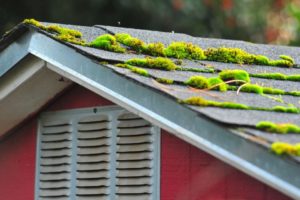Thick moss overtaking a roof can be picturesque. Lush green and verdant, it does give a house a fairy tale, Hobbit-like look. Beyond that, it contributes nothing else to a home and, in fact, will be seriously damaging if left unchecked.
When roof moss gets thick enough that it crowds out the shingles, there is no turning around at this point: the roof must be replaced.
A person remodels a house because it’s no longer stylistically suitable; because it’s not meeting functional needs; or because major repairs need to be made, and it turns out easier in the end just to completely remodel the thing.
No one has ever replaced an otherwise functional roof simply because it doesn’t meet stylistic needs. In most cases, roofs get replaced because they have reached the end of their natural lifespan or they have not been properly maintained.
If you maintain your roof well enough, you probably will not be replacing it. Have I driven the point home enough yet? I hope so, because now we’re going to kill some moss!
This guide covers two forms of moss removal applications: dry powder and liquid spray-on moss killers. Begin with an understanding on how moss develops on roofs.
How and Why It Happens
Areas lacking in sunlight are prone to moss. Moss on a roof begins as a thin dusting of green that you notice mostly from low angles.
Moss develops in perennially shady areas in places that tend to be cool and damp. You can live in a cool, damp area, but sections of the roof that get a couple of hours of sun per day may not develop moss.
It’s that third factor–lack of sun–that promotes moss growth.
Moss begins as a thin green layer on the tops of the shingles. The areas between shingles and the shingles’ edges also get moss because they are even more shaded.
As moss thickens, it will get under the shingles, acting like a jack and raising and pushing them upward.
Advertisement
Advertisement
It’s bad enough with asphalt or composite shingles, but if you have wood shingles it’s disastrous. Wood’s porous surface is prime real estate for moss growth. Once moss has adhered to wood shingles, it’s tougher to get off than the relatively smoother planes of composite or asphalt shingles.
Dry or Liquid Applications
■ Dry Powders
Dry powder moss killers are applied by first climbing the roof and sprinkling the application in lines parallel to the ridge of the house. Position each line about five feet from the adjoining line. Significant amounts of dry powder are required to cover a house. When it rains, the water will mix with the powder and run down toward the eaves. After about a week, the moss should clear.
One disadvantage of the dry powders is that white streaks remain on the roof until a hard rain or two have washed them away. Even then, chunked or caked powder may remain for several weeks.
Dry moss killers are very much hands-on. Often, you will find that you did not dispense enough powder on the first pass to kill the moss, necessitating another trip to the store for more product.
■ Liquids
Liquid applications attach to a garden hose and mix on a metered basis as the water runs. You can remain on the ground, as long as you have sufficient water pressure to reach the ridge of the roof. Liquid moss killers more evenly cover the roof than dry powders.
One advantage of liquids is that your roof will not have unsightly white lines of powder; the liquid is clear.
One disadvantage of liquid moss-killers is that they are difficult to visually follow. It is hard to keep track of where you have been and where you are going. One way to deal with this is to make sure that you start with a perfectly dry roof.
Liquid moss killers tend to be more expensive on a square foot by square foot basis than powdered moss killers.
Advertisement
Advertisement
If you do not like heights, liquid moss killers are the way to go. One compromise is to mount a ladder about halfway up and spray from that point. This allows you to better direct the spray, without climbing onto the roof.
Bayer 2-in-1 Algae and Moss Killer
Bayer 2-in-1 Algae and Moss Killer is potassium soap of fatty acids and inert ingredients in liquid form. Unlike zinc-based moss-killers, it claims to be non-corrosive to metals. Roofs do have a lot of metal–vents, gutters, drains, nails, cables–so this can be a plus.
Application is effortless. You screw the end of your garden hose to the bottle, turn on the water, and spray. You can even apply the product from the ground, no roof-climbing required.
The spray nozzle creates a nice, flat stream that’s easy to apply. Be careful because it’s easy to deplete the bottle long before you’ve covered all of your mossy area.
The solution runs through quickly, so hit your target once and move on. If you want to double-spray, do it after the initial run-through.
Moss B Ware
Moss B Ware is 99% zinc sulfate monohydrate, a proven moss killer and deterrent. In fact, one way to prevent moss from growing in the first place is to attach zinc strips to the ridge of your roof. Over time, as rain falls, zinc residue coats the roof, prevent moss-growth.
Cheapness and availability are strong suits. Moss B Ware is Home Depot’s favored roof moss killer.
Moss B Ware can be mixed with water at the rate of 3 pounds of product to 5-10 gallons of water, killing moss over 600 square feet, though this negates the visual-tracking properties of granular-based moss killers.
Moss B Ware does not deliver easily, as it is often caked up and hard. The product can be broken up by hitting the container against a hard surface or tapping it gently with a hammer. But the issue is that the cardboard container will not tolerate much abuse before it splits open.
With that flexible cardboard container, too, the plastic top tends to come loose. When this happens, you may end up with a large pile of product in one spot.
Lilly Miller Moss Out Review
Like Moss B Ware, Moss Out from Lilly Miller is 99% zinc sulfate monohydrate. Same active ingredients, different texture and delivery system.
Moss Out is more granular-–less powdery–than Moss B Ware. This makes it easier to shake out.
Moss Out’s 6 lb. plastic container is a bit heavy to hold when you first start shaking, but it lightens up pretty fast.

